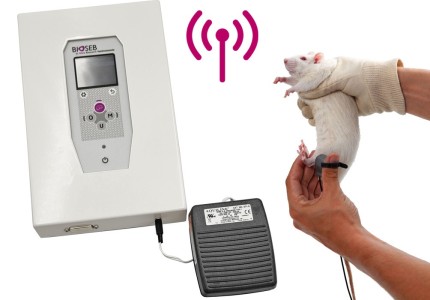Authors
Kim JS, Ahmadinia K, Li X, Hamilton JL, Andrews S, Haralampus CA, Xiao G, Sohn HM, You JW, Seo YS, Stein GS8, Van Wijnen AJ, Kim SG, Im HJ
Lab
The Division of Natural Medical Sciences, College of Health Science, Chosun University, Gwangju, Republic of Korea.
Journal
J Cell Physiol.
Abstract
We report generation and characterization of pain-related behavior in a minimally invasive facet joint degeneration (FJD) animal model in rats. FJD was produced by a non-open percutaneous puncture-induced injury on the right lumbar FJs at three consecutive levels. Pressure hyperalgesia in the lower back was assessed by measuring the vocalization response to pressure from a force transducer. After hyperalgesia was established, pathological changes in lumbar FJs and alterations of intervertebral foramen size were assessed by histological and imaging analyses. To investigate treatment options for lumber FJ osteoarthritis-induced pain, animals with established hyperalgesia were administered with analgesic drugs, such as morphine, a selective COX-2 inhibitor, a non-steroidal anti-inflammatory drug (NSAID) (ketorolac), or pregabalin. Effects were assessed by behavioral pain responses. One week after percutaneous puncture-induced injury of the lumbar FJs, ipsilateral primary pressure hyperalgesia developed and was maintained for at least 12 weeks without foraminal stenosis. Animals showed decreased spontaneous activity, but no secondary hyperalgesia in the hind paws. Histopathological and microfocus X-ray computed tomography analyses demonstrated that the percutaneous puncture injury resulted in osteoarthritis-like structural changes in the FJs cartilage and subchondral bone. Pressure hyperalgesia was completely reversed by morphine. The administration of celecoxib produced moderate pain reduction with no statistical significance while the administration of ketorolac and pregabalin produced no analgesic effect on FJ osteoarthritis-induced back pain. Our animal model of non-open percutanous puncture-induced injury of the lumbar FJs in rats shows similar characteristics of low back pain produced by human facet arthropathy.
BIOSEB Instruments Used
SMALGO: SMall animal ALGOmeter (BIO-SMALGO)
Source :

 Pain - Thermal Allodynia / Hyperalgesia
Pain - Thermal Allodynia / Hyperalgesia Pain - Spontaneous Pain - Postural Deficit
Pain - Spontaneous Pain - Postural Deficit Pain - Mechanical Allodynia / Hyperalgesia
Pain - Mechanical Allodynia / Hyperalgesia Learning/Memory - Attention - Addiction
Learning/Memory - Attention - Addiction Physiology & Respiratory Research
Physiology & Respiratory Research











![Dynamic Weight Bearing 2.0 – Postural Module [Add-on]](https://bioseb.com/733-home_default/dynamic-weight-bearing-20-add-on-postural-module.jpg)
























 Pain
Pain Central Nervous System (CNS)
Central Nervous System (CNS) Neurodegeneration
Neurodegeneration Sensory system
Sensory system Motor control
Motor control Mood Disorders
Mood Disorders Other disorders
Other disorders Muscular system
Muscular system Joints
Joints Metabolism
Metabolism Cross-disciplinary subjects
Cross-disciplinary subjects CONFERENCES & MEETINGS
CONFERENCES & MEETINGS 